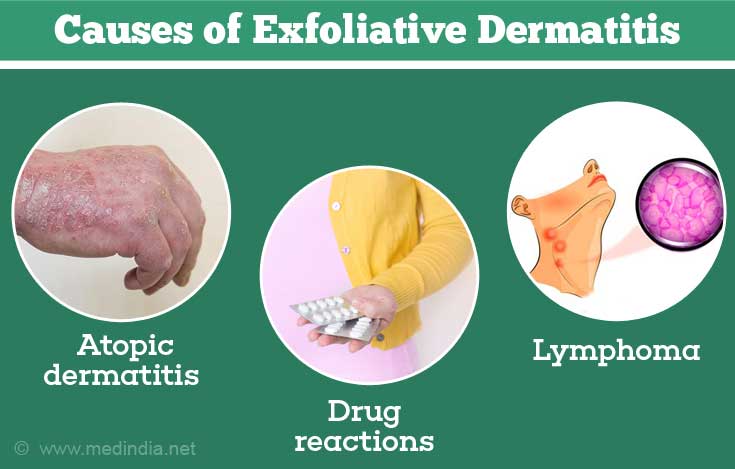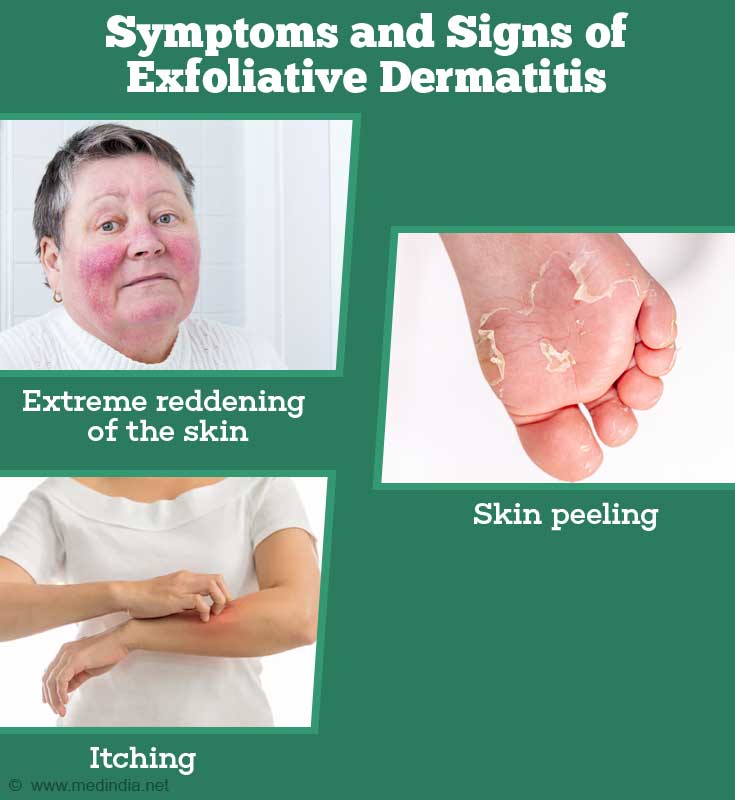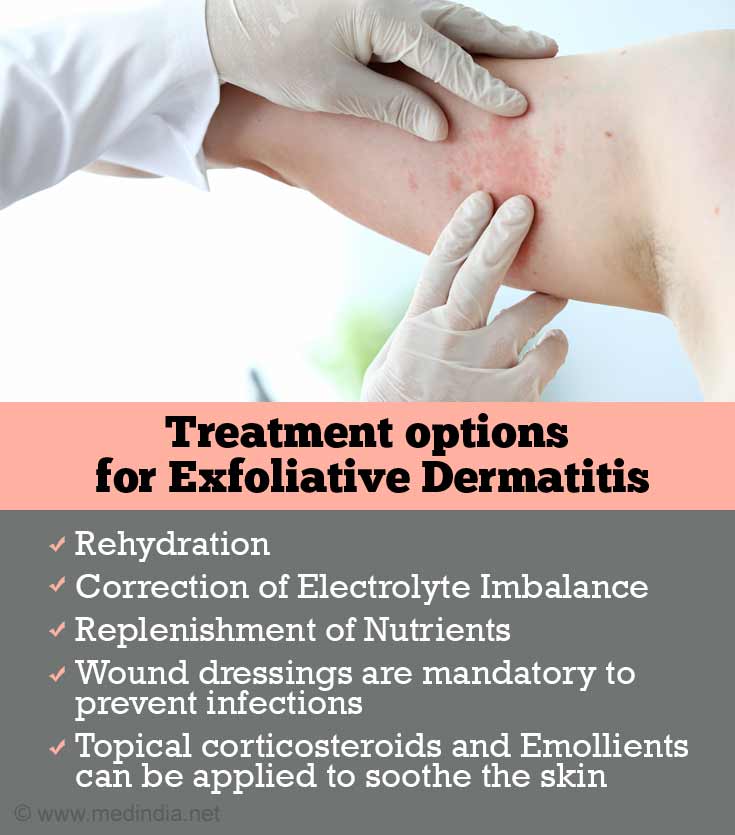- Exfoliative dermatitis: American Family Physician - (https://www.aafp.org/afp/1999/0201/p625.html)
- Generalized exfoliative dermatitis: University of Rochester Medical Center - (https://www.urmc.rochester.edu/encyclopedia/content.aspx?ContentTypeID=85&ContentID=P00287)
- Yacoub MR, Berti A, Campochiaro C, Tombetti E, Ramirez GA, Nico A, Di Leo E, Fantini P, Sabbadini MG, Nettis E, Colombo G. Drug induced exfoliative dermatitis: state of the art. Published in Clin Mol Allergy. 2016 - (https://www.urmc.rochester.edu/encyclopedia/content.aspx?ContentTypeID=85&ContentID=P00287)
- Karakayli G, Beckham G, Orengo I, Rosen T. Exfoliative dermatitis. Published in Am Fam Physician 1999 - (https://www.urmc.rochester.edu/encyclopedia/content.aspx?ContentTypeID=85&ContentID=P00287)
- Okoduwa C, Lambert WC, Schwartz RA, Kubeyinje E, Eitokpah A, Sinha S, Chen W. Erythroderma: review of a potentially life-threatening dermatosis. Published in Indian J Dermatol 2009 - (https://www.urmc.rochester.edu/encyclopedia/content.aspx?ContentTypeID=85&ContentID=P00287)
- Sehgal VN, Srivastava G. Exfoliative dermatitis. A prospective study of 80 patients. Published in Dermatologica 1986 - (https://www.urmc.rochester.edu/encyclopedia/content.aspx?ContentTypeID=85&ContentID=P00287)
What is Exfoliative Dermatitis?
Exfoliative dermatitis is a skin condition in which the skin becomes inflamed (dermatitis) and the skin peels-off (exfoliation) over large areas of the body. The affected areas become reddened (erythema), accompanied by irritation and pain. This condition can occur due to pre-existing skin disorders, cancer, drug-induced (iatrogenic) or without any known cause (idiopathic).
Generalized exfoliative dermatitis in which the peeling of skin occurs extensively (more than 90% of the body surface), the condition is termed as erythroderma. The condition was first described by Von Hebra in 1868.
Exfoliative dermatitis occurs in all races and ethnic groups, with men being affected more than women (male-to-female ratio varies between 2:1 and 4:1). The average age of onset can vary from 52 to 60 years.
What is the Incidence of Exfoliative Dermatitis in India?
The actual incidence of exfoliative dermatitis is unknown. A handful of studies have been carried out across the globe. With regard to the Indian population a large prospective study involving 80 patients was carried out where it was found that the incidence of exfoliative dermatitis is 35 per 100,000 dermatologic out-patients.
Anatomy & Physiology of the Skin
The skin is considered as the largest organ of the human body and provides a protective covering against toxic insult (poisoning, injury or irritation) as well as environmental pathogens (microorganisms in the environment that can harm the human body).
The skin consists of three layers: The epidermis, dermis and hypodermis.
The outermost thin layer of the skin, which is exposed to the external environment is called epidermis. Its surface is covered with a protective protein layer composed of keratin. This makes the epidermis tough and water-resistant. The epidermis also contains melanin pigments that impart the skin tone. Interestingly, the epidermis is devoid of any blood vessels. Importantly, the epidermis helps in vitamin D synthesis upon exposure to sunlight.
Located below the epidermis, is a much thicker layer called the dermis. It bears numerous hair follicles, sweat glands and sebaceous glands. This layer is rich in lymphatic vessels as well as blood capillaries. These are innervated by nerves that are responsible for the touch sensation.
The hypodermis is located below the dermis. This layer consists of fatty tissue and connective tissue. Importantly, this layer is not strictly part of the skin. The fatty layer provides cushioning and insulation for the body and the connective tissues help to attach the skin to the underlying muscles.
What are the Causes of Exfoliative Dermatitis?
Exfoliative dermatitis is usually caused by the following conditions:
- Skin Disorders: Pre-existing skin disorders can cause exfoliative dermatitis. These include atopic dermatitis, contact dermatitis, seborrheic dermatitis, psoriasis, lichen planus, and pityriasis rubra pilaris.
- Drug Reactions: Drugs such as antibiotics (penicillin, isoniazid, sulfonamides, cephalosporins); psychiatric drugs (barbiturates, carbamazepine, phenytoin, lithium); blood pressure medications (calcium channel blockers, β-blockers, α-blockers, ACE inhibitors etc.); and topical medicines (clotrimazole).
- Cancer: These primarily include leukemia and lymphoma.
It should be noted that about 30% of patients have no known cause (idiopathic) for the exfoliative dermatitis.

What are the Symptoms and Signs of Exfoliative Dermatitis?
Some of the common symptoms and signs of exfoliative dermatitis include the following:
- Extreme reddening of the skin
- Skin peeling
- Itching
- Thickened and ridged nails
- Swollen lymph nodes
- Fever and chills
- Malaise

Severe Symptoms
When patients have severe symptoms, it can be life-threatening. Some of the major symptoms include the following:
- Abnormal temperature regulation due to extensive skin shedding.
- Nutritional deficiencies because of extensive protein loss.
- Increased metabolic rate with high rate of catabolism.
- Low blood volume (hypovolemia) due to fluid losses from the surface.
- Fluid and electrolyte abnormalities.
- Secondary infections (bacterial or viral) due to the broken skin.
The above symptoms can lead to death. The immediate cause of death includes the following:
- Septicemia
- Pneumonia
- Heart failure
What are the Risk Factors of Exfoliative Dermatitis?
The risk-factors of exfoliative dermatitis often overlap with its causes or etiology. Some of the risk-factors include the following:
- Age: The age of the patient is a major risk-factor, since exfoliative dermatitis tends to occur at an older age, usually above 50 years. However, there is a possibility that it can occur in younger age groups also.
- Sex: The sex of the patient is another risk-factor, since males can be 2 to 4 times more likely to get this disease than females.
- Drugs: Drugs acting on the central nervous system (CNS) like carbamazepine, phenytoin, lithium and sodium valproate, which are used to treat psychiatric diseases. Others include antibiotics like vancomycin and sulfonamides, which can also precipitate exfoliative dermatitis, particularly in patients who have a weakened immune system such as AIDS patients.
- Pre-existing Skin Conditions: Pre-existing skin conditions, for example, atopic dermatitis and contact dermatitis can lead to or worsen exfoliative dermatitis. Moreover, various types of malignancies, particularly skin cancers such as cutaneous T-cell lymphoma can lead to exfoliative dermatitis.
How do you Diagnose Exfoliative Dermatitis?
Diagnosis is primarily based on a detailed medical history and clinical examination. A trained dermatologist can diagnose the condition upon simple observation. Laboratory evaluation of patients with erythroderma is not helpful for establishing a specific diagnosis. Blood tests are also of no diagnostic value. Tissue biopsy is usually non-specific, with the only exception being in case of mycosis fungoides.
How do you Treat Exfoliative Dermatitis?
Depending upon the severity, treatment can be done in a hospital setting or at home in consultation with a dermatologist. Treatment usually involves supportive care, so that the symptoms can be corrected and complications avoided.
- Rehydration: Dehydration is very common as fluids can escape from the body surface due to the absence of the protective layer of skin. Dehydration can lead to hypovolemic shock, which can be life-threatening. Therefore, prompt rehydration is very important. Rehydration can be carried out orally if possible or otherwise it has to be given intravenously.
- Correction of Electrolyte Imbalance: Correction of electrolyte abnormalities is essential and can be done while rehydrating the patient.
- Replenishment of Nutrients: Valuable nutrients are lost as a result of erythroderma. These need to be replenished at regular intervals to keep the internal organs functioning properly.
- Prevention of Infections: The patient should be observed for any bacterial superinfection, as this can lead to complications like septicemia. Wound dressings are mandatory to prevent these infections. Antibiotics should be kept ready in case infections do occur.
- Soothing the Skin: Emollients can be applied to soothe the skin. Colloidal oatmeal baths also have a soothing effect.
- Administration of Corticosteroids: Topical corticosteroids such as hydrocortisone (1 to 2.5%) ointment can be applied on the skin. In case of severe disease, prednisone (40 to 60 mg) is recommended for oral administration, once daily for 10 days and then tapered-off.

What is the Prognosis for Exfoliative Dermatitis?
The prognosis or outlook for exfoliative dermatitis can vary from patient-to-patient and depends on the cause.
- Drug Allergy: If drug-allergy is the cause, it usually responds when the offending drug is withdrawn. With supportive care, complete healing occurs within 2-6 weeks.
- Cancer: In case of cancer, the response is variable since it depends on how the cancer progresses and responds to therapy.
- Idiopathic: In case of exfoliative dermatitis that has no known cause, the prognosis is poor. This is usually long-drawn, requiring continuous steroid therapy. There may be periods of remission interspersed with worsening of the condition and flare-ups, which may occur throughout life. The long-term effects include permanent discoloration of the skin. Others include hair loss (alopecia) and changes in the nails.






